Study of Secondary Effects of Fatigue Cracks in Cross Partitions of Steel Plate Reinforced Steel Box Girders
Abstract
:1. Introduction
2. Engineering Background
2.1. Fatigue Disease Statistics
2.2. Repair Plan for Fatigue Crack of Arc-Shaped Cut of the Transverse Diaphragm
3. Finite Element Analysis
3.1. Finite Element Modeling of Arc-Shaped Incisions
3.2. Cross Partition Curved Cut Reinforcement
4. Experimental Test Plan
4.1. Load Car Parameters
4.2. Deployment Plan
4.3. Measuring Point Layout
- (1)
- Arrangement of measuring points on the arc-shaped incision section
- (2)
- Layout of measuring points on the side of the diaphragm
- (3)
- U-rib measuring point layout
- (4)
- The layout of measuring points on the bridge deck
5. Test Results and Analysis
5.1. Test Results Stress Analysis of the Arc-Shaped Cut of the Diaphragm
- (1)
- Principal compressive stress under longitudinal loading
- (2)
- Principal compressive stress under transverse loading conditions
5.2. Results of Stress Analysis on the Side of the Diaphragm
- (1)
- Side measurement points of the junction area between the arc-shaped incision and the U-rib
- (2)
- Side measurement point of the arc starting point of arc-shaped incision
5.3. Test Stress and Analysis of U-Rib Side
5.4. Test Stress and Analysis of Bridge Deck
6. Conclusions
Author Contributions
Funding
Institutional Review Board Statement
Informed Consent Statement
Data Availability Statement
Acknowledgments
Conflicts of Interest
References
- Zhang, Q.H.; Bu, Y.Z.; Li, Q. Progress of research on fatigue of orthotropic anisotropic steel bridge panels. China J. Highw. 2017, 30, 14–30. [Google Scholar]
- Liu, Y.; Zhang, Q.; Meng, W.; Bao, Y.; Bu, Y. Transverse fatigue behaviour of steel-UHPC composite deck with large-size U-ribs. Eng. Struct. 2019, 180, 388–399. [Google Scholar] [CrossRef]
- Li, H.; Wu, G. Fatigue Evaluation of Steel Bridge Details Integrating Multi-Scale Dynamic Analysis of Coupled Train-Track-Bridge System and Fracture Mechanics. Appl. Sci. 2020, 10, 3261. [Google Scholar] [CrossRef]
- Fu, Z.; Ji, B.; Zhang, C.; Wang, Q. Fatigue Performance of Roof and U-Rib Weld of Orthotropic Steel Bridge Deck with Different Penetration Rates. J. Bridge Eng. 2017, 22, 04017016. [Google Scholar] [CrossRef]
- Kolstein, M.H.; Cuninghame, J.R.; Bruls, A. European Research on the Improvement of the Fatigue Resistance and Design of Steel Orthotropic Bridge Decks. In Advances in Steel Structures (ICASS ‘96), Proceedings of International Conference on Advances in Steel Structures, Hong Kong, China, 11–14 December 1996; Elsevier: Amsterdam, The Netherlands, 1996; pp. 541–546. [Google Scholar]
- Zhu, Z.; Yuan, T.; Xiang, Z.; Huang, Y.; Zhou, Y.E.; Shao, X. Behavior and Fatigue Performance of Details in an Orthotropic Steel Bridge with UHPC-Deck Plate Composite System under In-Service Traffic Flows. J. Bridge Eng. 2017, 23, 04017142. [Google Scholar]
- Peng, X.; Zhou, X.H.; Di, J.; Qin, F.J.; Wang, J. Fatigue damage characteristics of steel bridge panel longitudinal ribs and transverse diaphragm connection location. China J. Highw. 2018, 31, 78–90. [Google Scholar]
- Chen, Z.Y.; Li, C.X.; He, J.; Xin, H.H. Retrofit Fatigue Cracked Diaphragm Cutouts Using Improved Geometry in Orthotropic Steel Decks. Appl. Sci. 2020, 10, 3983. [Google Scholar] [CrossRef]
- Chen, Y.; Lv, P.; Li, D. Research on Fatigue Strength for Weld Structure Details of Deck with U-rib and Diaphragm in Orthotropic Steel Bridge Deck. Metals 2019, 9, 484. [Google Scholar] [CrossRef] [Green Version]
- Zhang, S.; Shao, X.; Cao, J.; Cui, J.; Hu, J.; Deng, L. Fatigue Performance of a Lightweight Composite Bridge Deck with Open Ribs. J. Bridge Eng. 2016, 21, 04016039. [Google Scholar] [CrossRef]
- Shao, X.; Yi, D.; Huang, Z.; Zhao, H.; Chen, B.; Liu, M. Basic Performance of the Composite Deck System Composed of Orthotropic Steel Deck and Ultrathin RPC Layer. J. Bridge Eng. 2013, 18, 417–428. [Google Scholar]
- Zhu, Z.W.; Hua, Y.; Wen, P.X.; Chen, W.; Yu, P.; Shi, Y.G.; Shao, X.D. Study on fatigue performance of steel-UHPC combined orthotropic anisotropic bridge deck under random traffic flow. China J. Highw. 2017, 30, 200–209. [Google Scholar]
- Choi, J.H.; Kim, D.H. Stress Characteristics and Fatigue Crack Behaviour of the Longitudinal Rib-to-Cross Beam Joints in an Orthotropic Steel Deck. Adv. Struct. Eng. 2009, 11, 189–198. [Google Scholar] [CrossRef]
- Fu, Z.Q.; Ji, B.H.; Xie, S.H.; Liu, T.J. Crack stop holes in steel bridge decks: Drilling method and effects. J. Cent. South Univ. 2017, 24, 2372–2381. [Google Scholar] [CrossRef]
- Delzendehrooy, F.; Akhavan-Safar, A.; Barbosa, A.Q.; Beygi, R.; Cardoso, D.; Carbas, R.J.; Marques, E.A.; da Silva, L.F. A comprehensive review on structural joining techniques in the marine industry. Compos. Struct. 2022, 289, 115490. [Google Scholar] [CrossRef]
- Wolchuk, R. Design Manual for Orthotropic Steel Plate Deck Bridges; American Institute of Steel Construction: Chicago, IL, USA, 1963. [Google Scholar]
- Chen, Z.Y.; Li, C.X.; Ke, L.; Guo, L.C.; Song, G.B. Fatigue Crack Repair and Optimization of Cope Holes in Orthotropic Steel Decks. China J. Highw. 2021, 34, 301–312. [Google Scholar]
- De Corte, W. Parametric study of floor beam cutouts for orthotropic bridge decks to determine shape factors. Bridge Struct. 2009, 5, 75–85. [Google Scholar]
- Zhu, Z.; Xiang, Z.; Li, J.; Huang, Y.; Ruan, S. Fatigue behavior of orthotropic bridge decks with two types of cutout geometry based on field monitoring and FEM analysis. Eng. Struct. 2020, 209, 109926. [Google Scholar] [CrossRef]
- Connor, R.J. A Comparison of the In-Service Response of an Orthotropic Steel Deck with Laboratory Studies and Design Assumption. Ph.D. Thesis, Lehigh University, Bethlehem, PA, USA, May 2002. [Google Scholar]
- Li, C.X.; Li, Y.; Chen, Z.Y.; Ke, L. Fatigue Cracking Reason and Detail Dimension of Reinforcement About Transverse Diaphragm of Steel Box Girder. China J. Highw. 2017, 30, 121–131. [Google Scholar]
- Abedin, M.; De Caso YB, F.J.; Kiani, N.; Mehrabi, A.B.; Nanni, A. Bridge load testing and damage evaluation using model updating method. Eng. Struct. 2022, 252, 113648. [Google Scholar] [CrossRef]
- Yao, Y.; Yan, M.; Shi, Z.; Wang, Y.; Bao, Y. Mechanical behavior of an innovative steel–concrete joint for long-span railway hybrid box girder cable-stayed bridges. Eng. Struct. 2021, 239, 112358. [Google Scholar] [CrossRef]
- He, Y.; Wang, K.; Cao, Z.; Zheng, P.; Xiang, Y. Reinforcement Analysis of an Old Multi-Beam Box Girder Based on a New Embedded Steel Plate (ESP) Strengthening Method. Materials 2022, 15, 4353. [Google Scholar] [CrossRef] [PubMed]
- Song, G.J.; Hua, L.H. Research on crack analysis and reinforcement method of a steel box girder transverse diaphragm of a cable-stayed bridge. Bridge Constr. 2014, 44, 107–111. [Google Scholar]
- Yu, Y.; Kurian, B.; Zhang, W.; Cai, C.S.; Liu, Y. Fatigue damage prognosis of steel bridges under traffic loading using a time-based crack growth method. Eng. Struct. 2021, 237, 112162. [Google Scholar] [CrossRef]

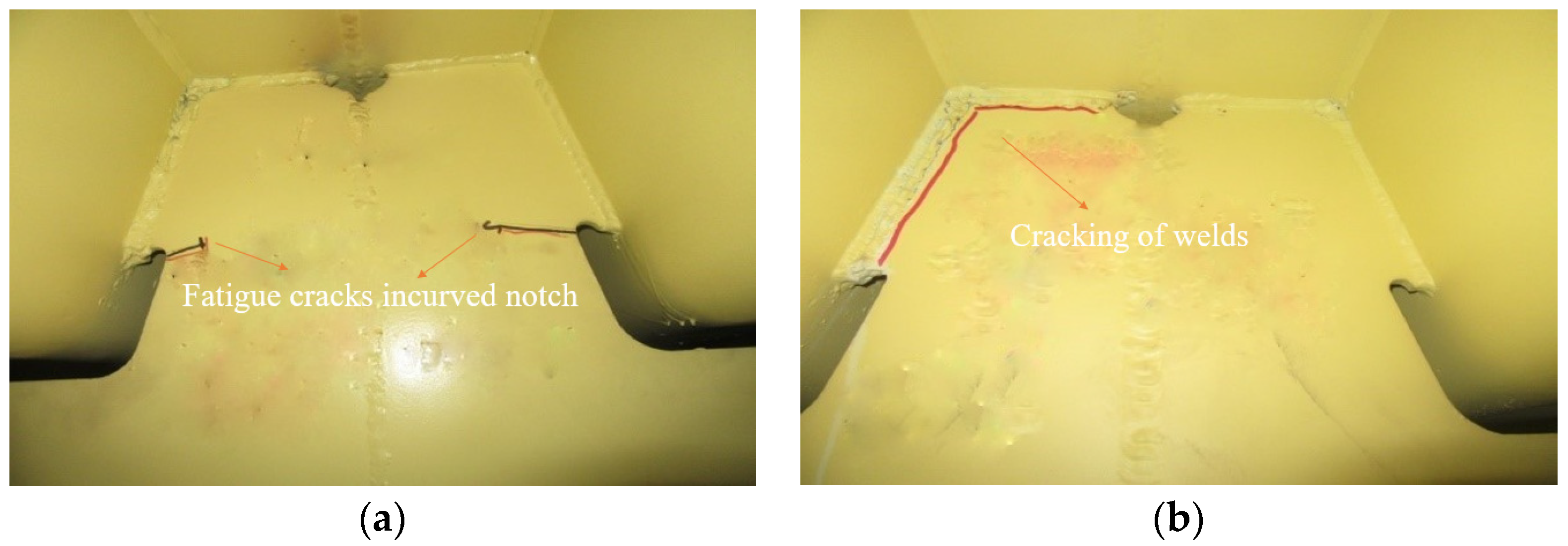

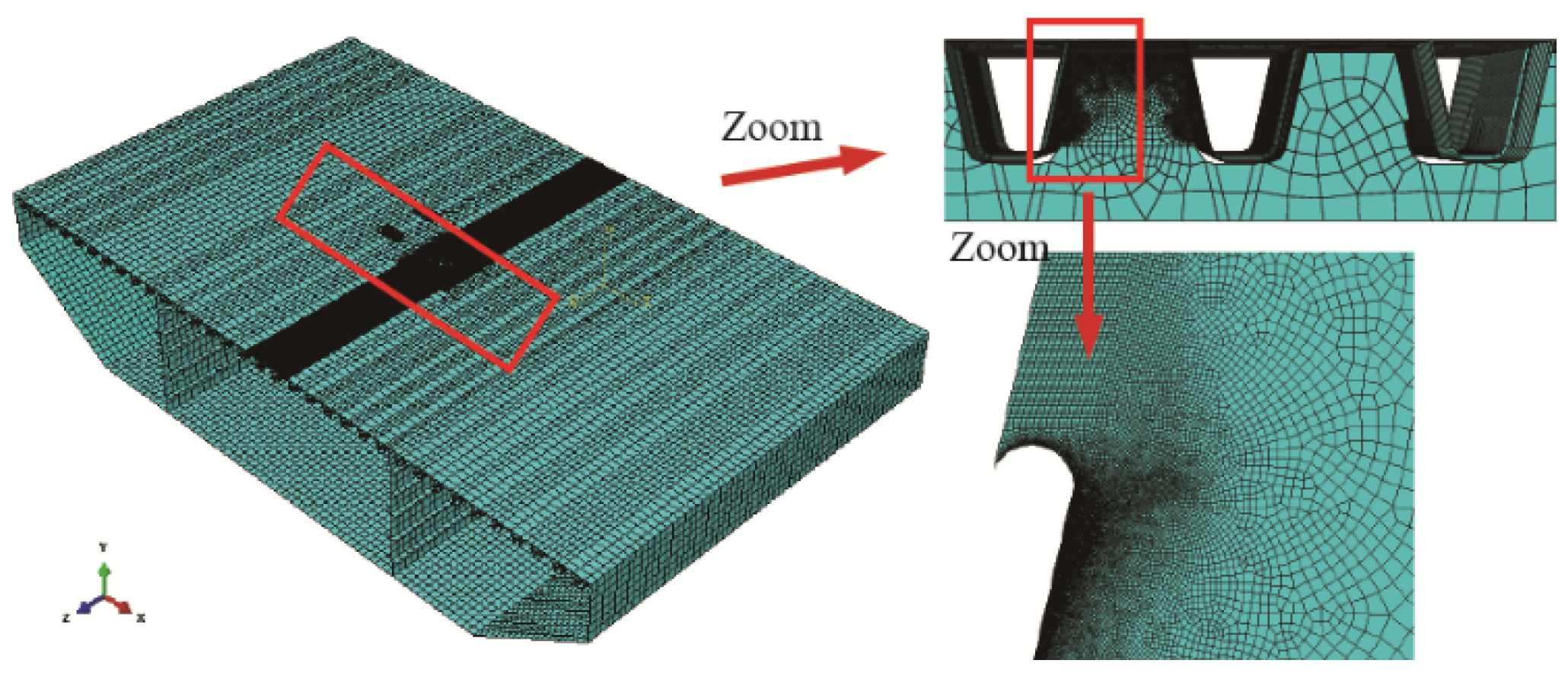

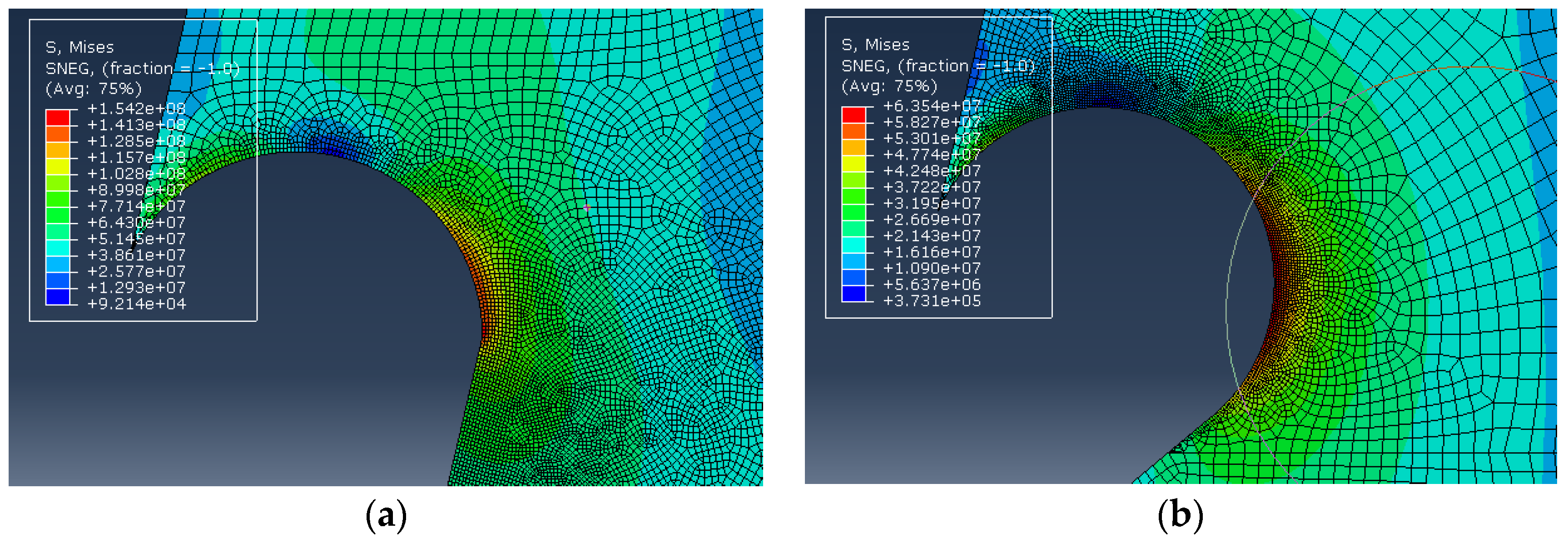
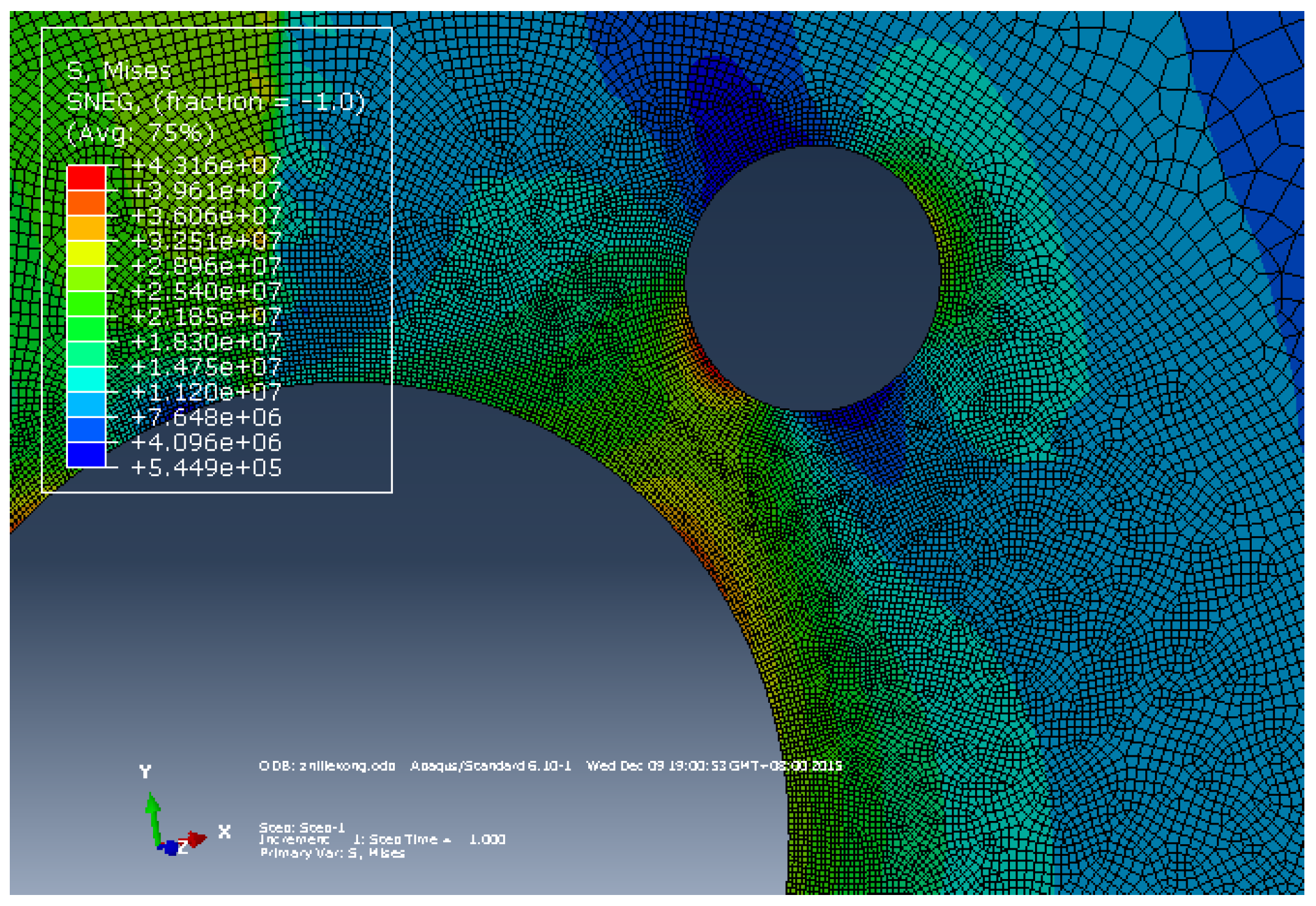
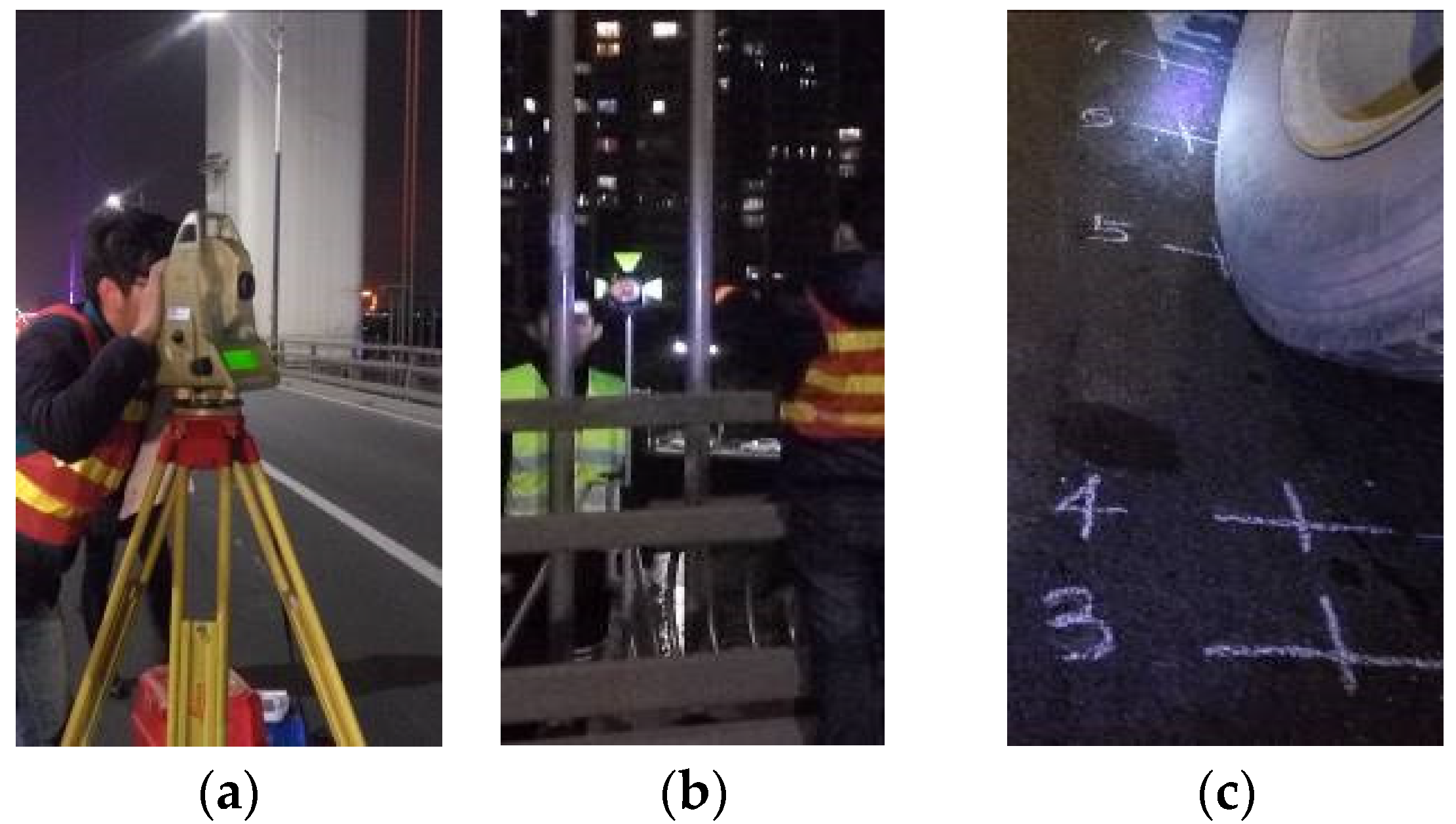
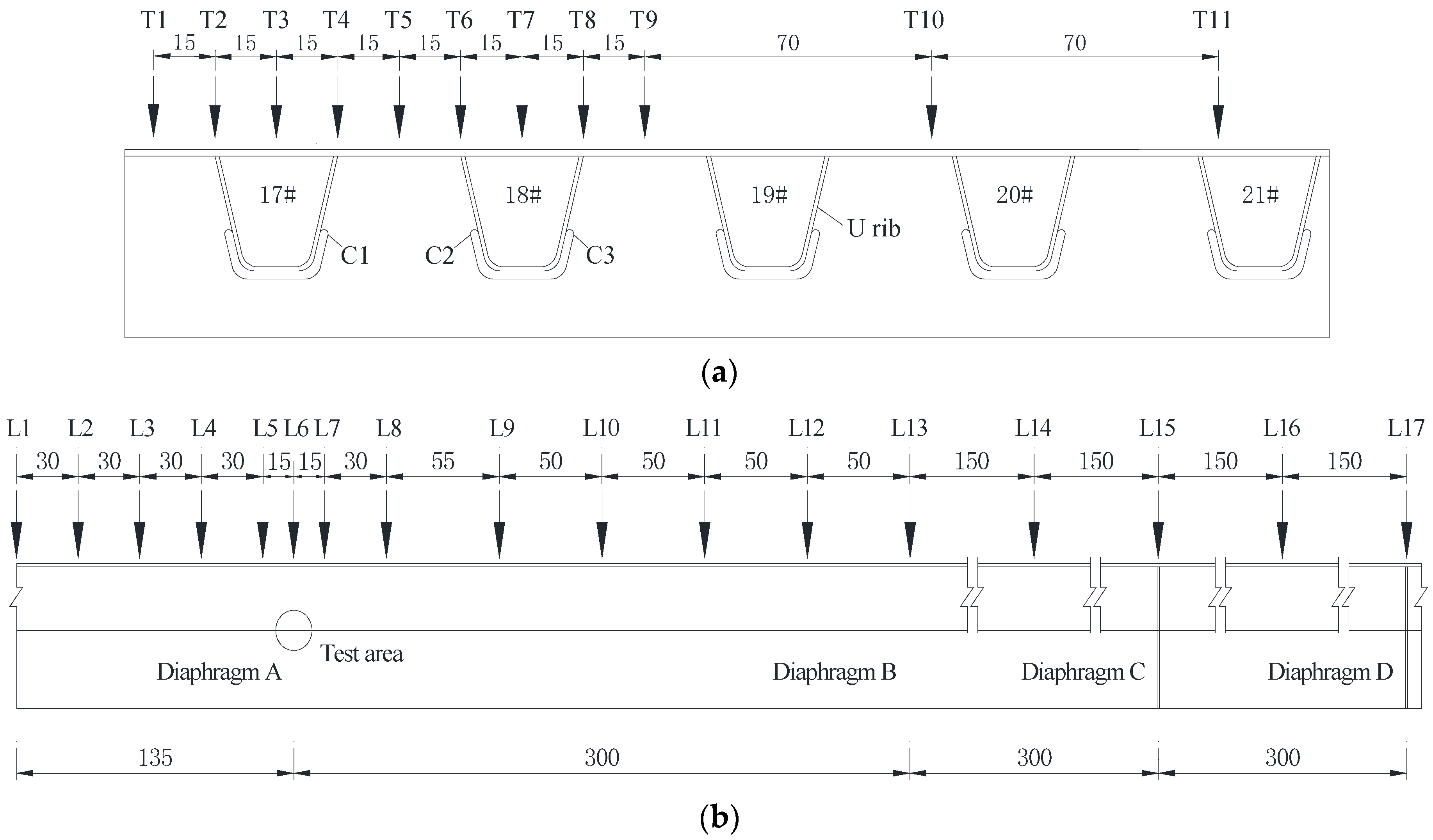



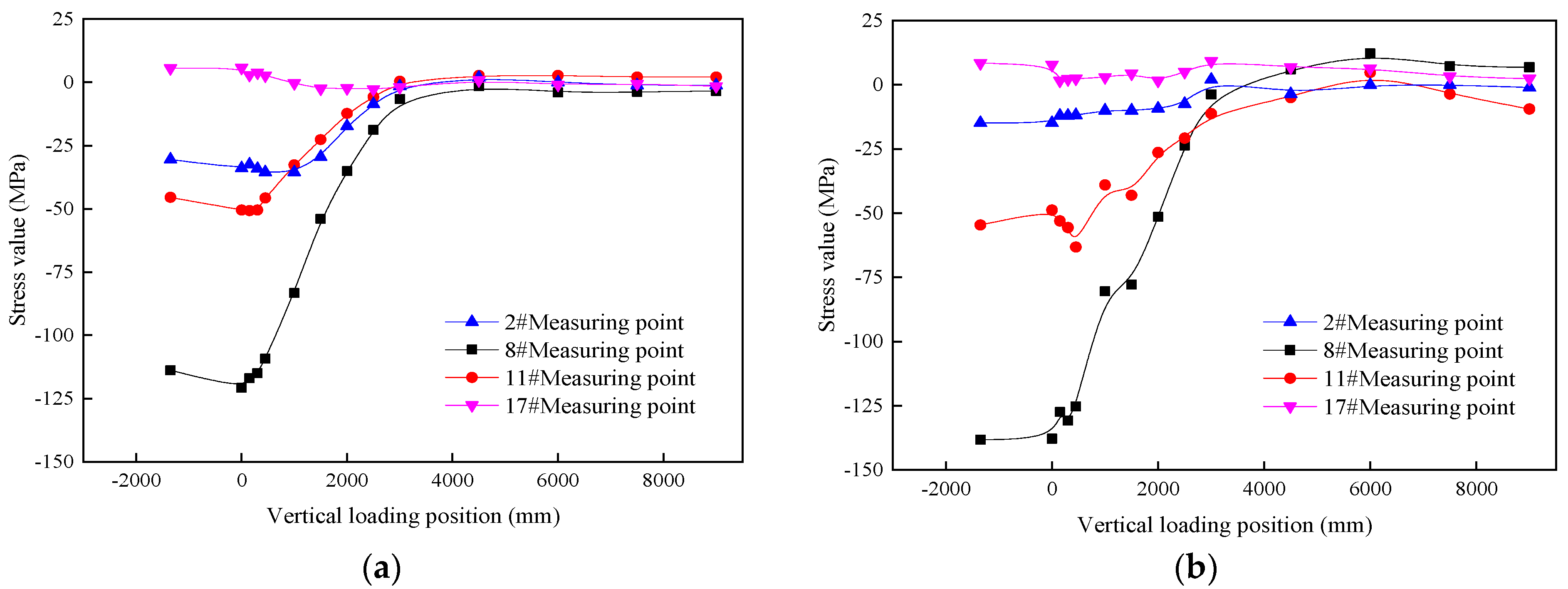
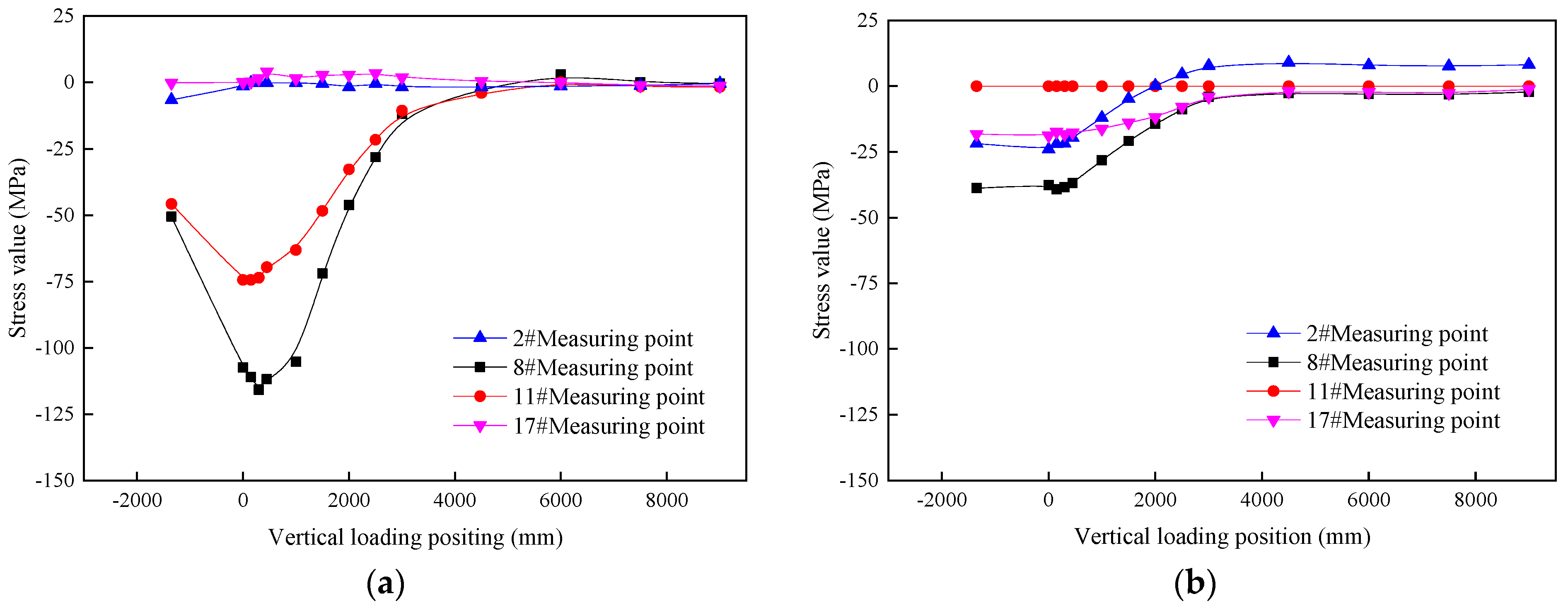
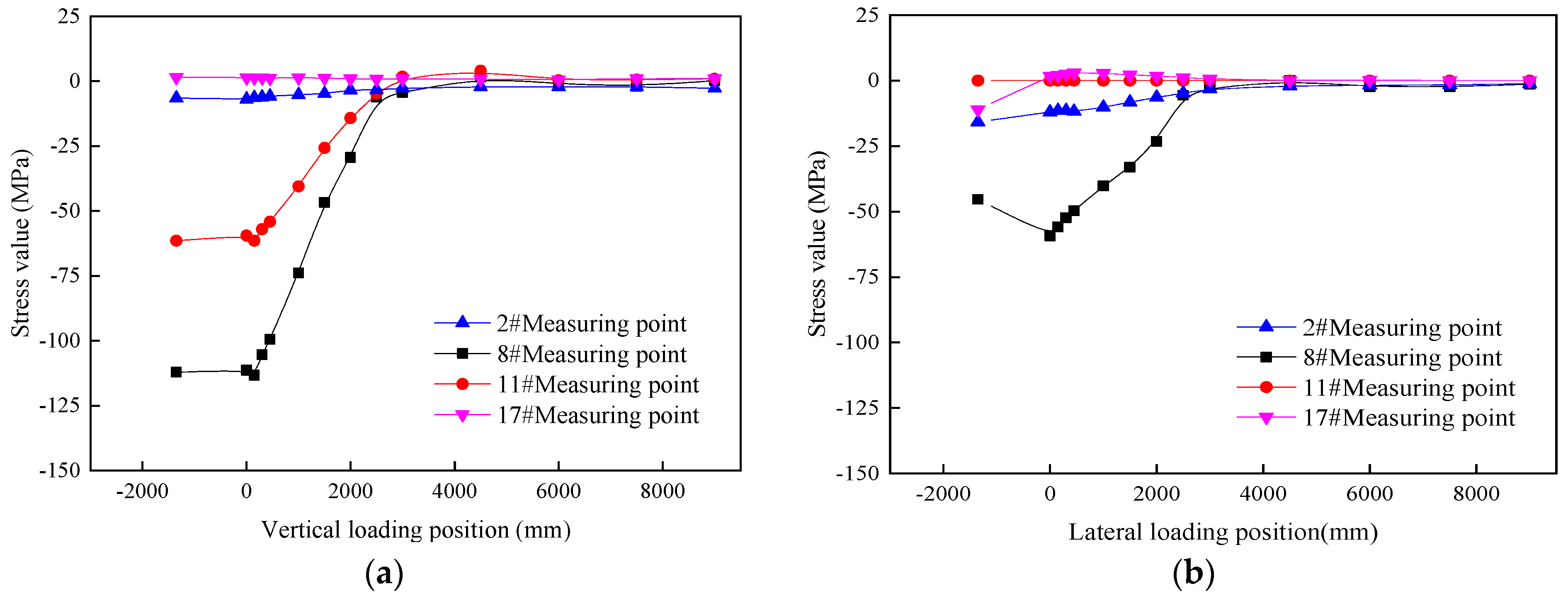
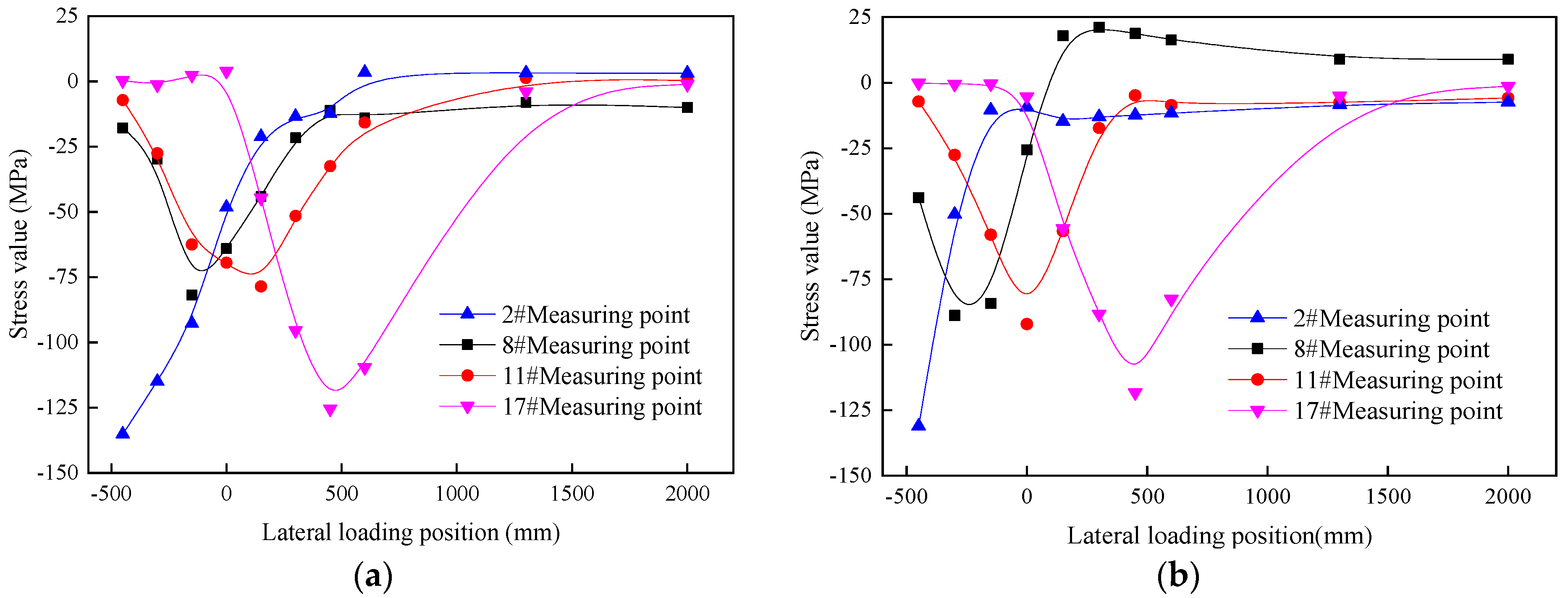
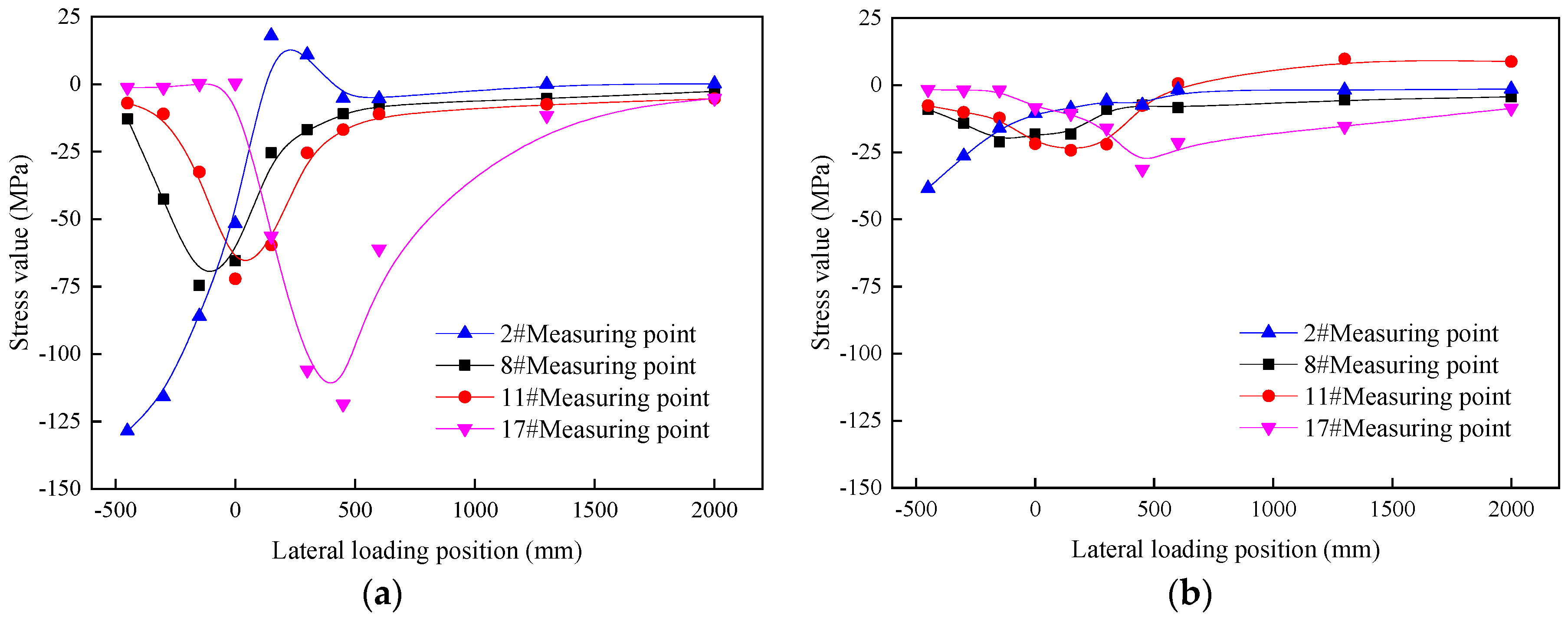
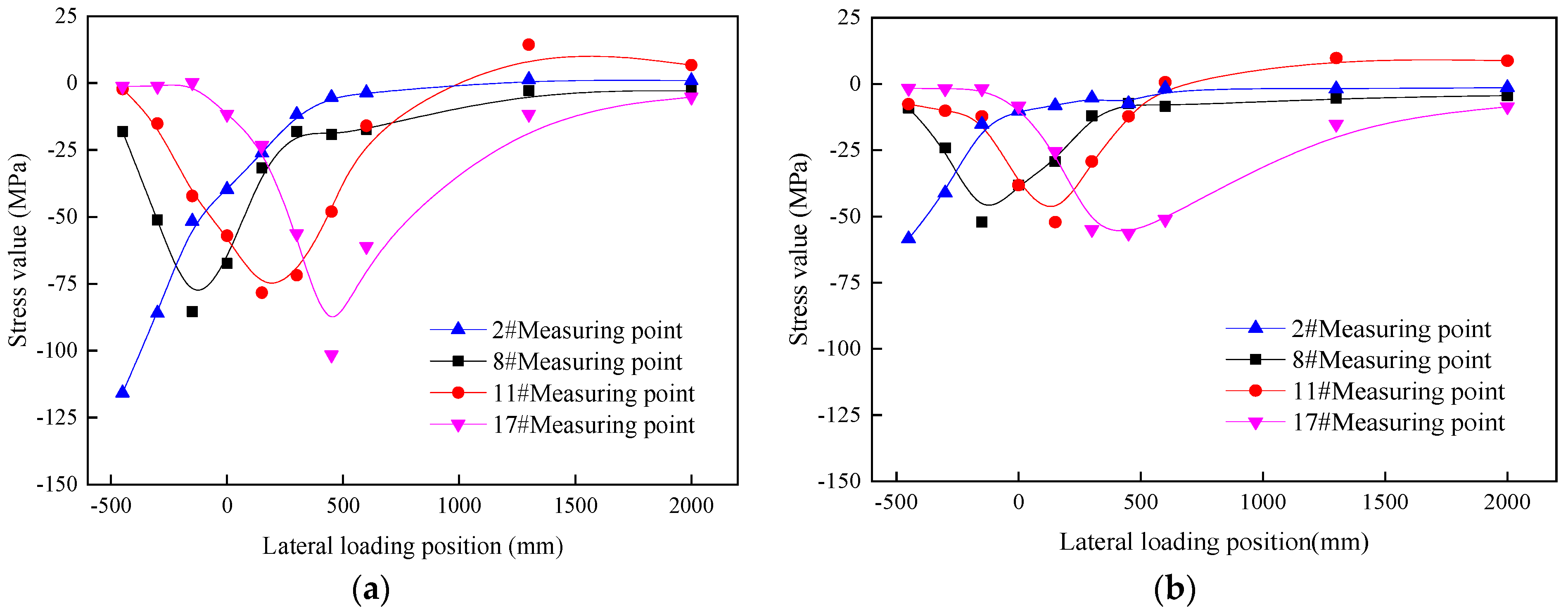
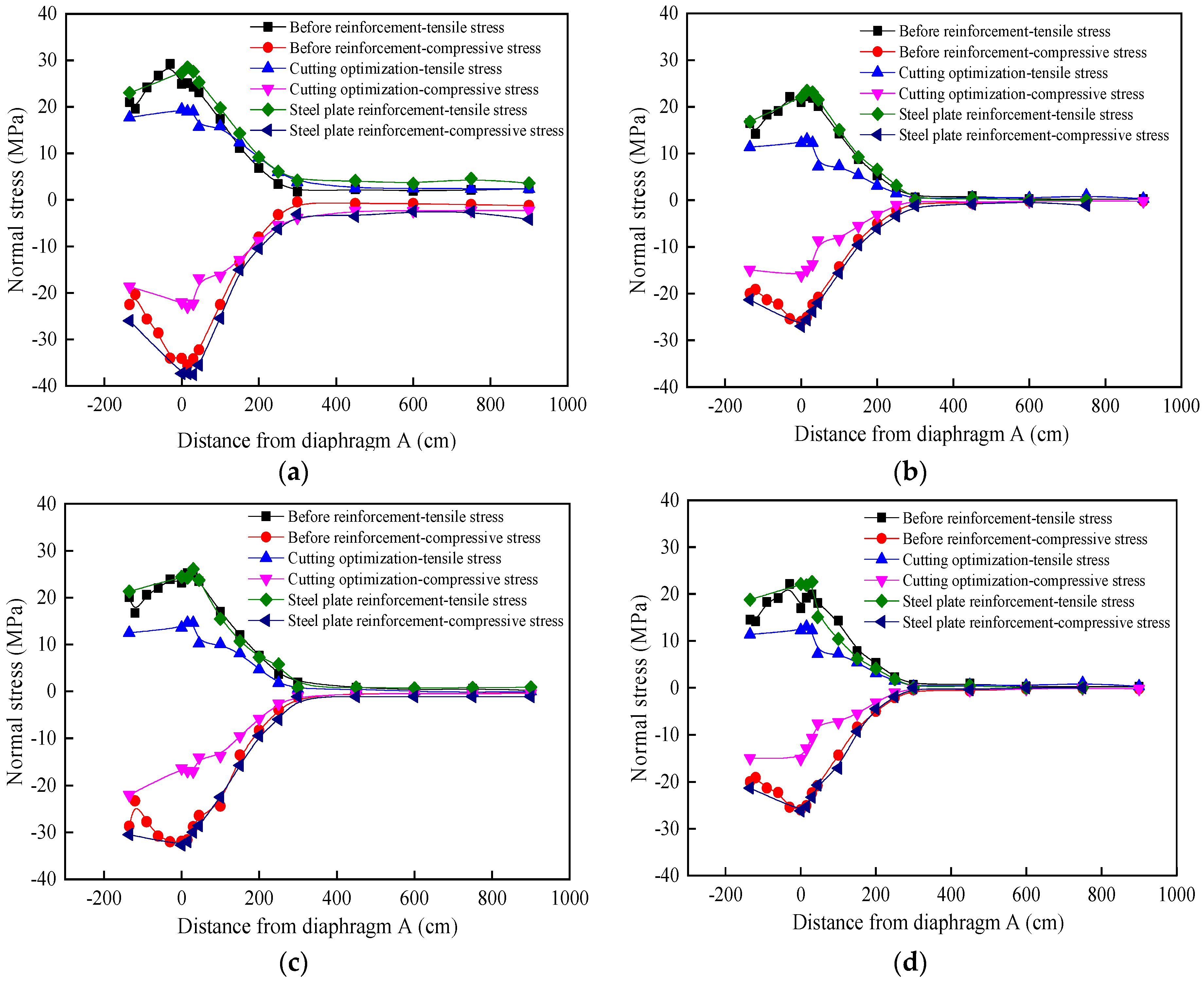
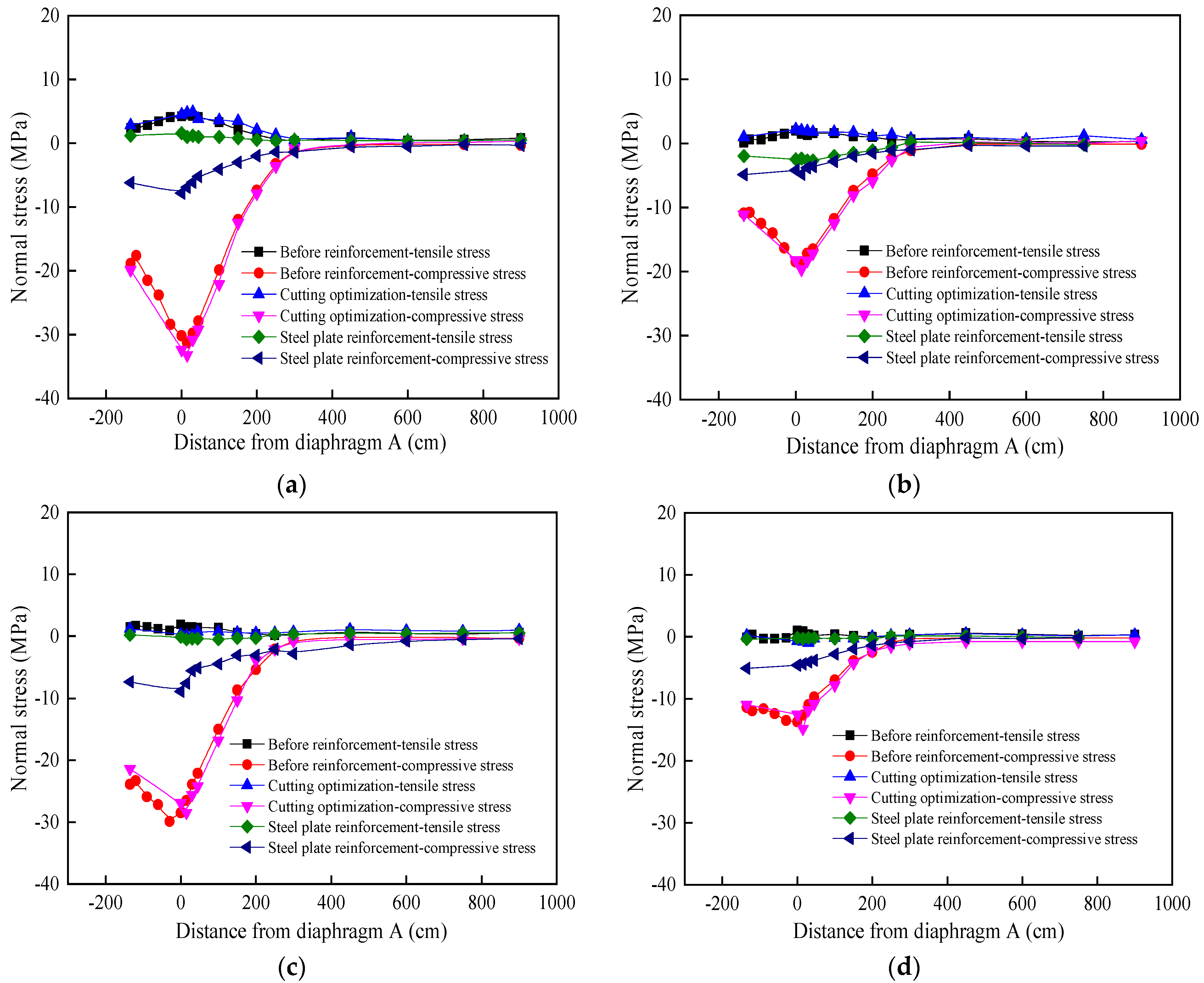
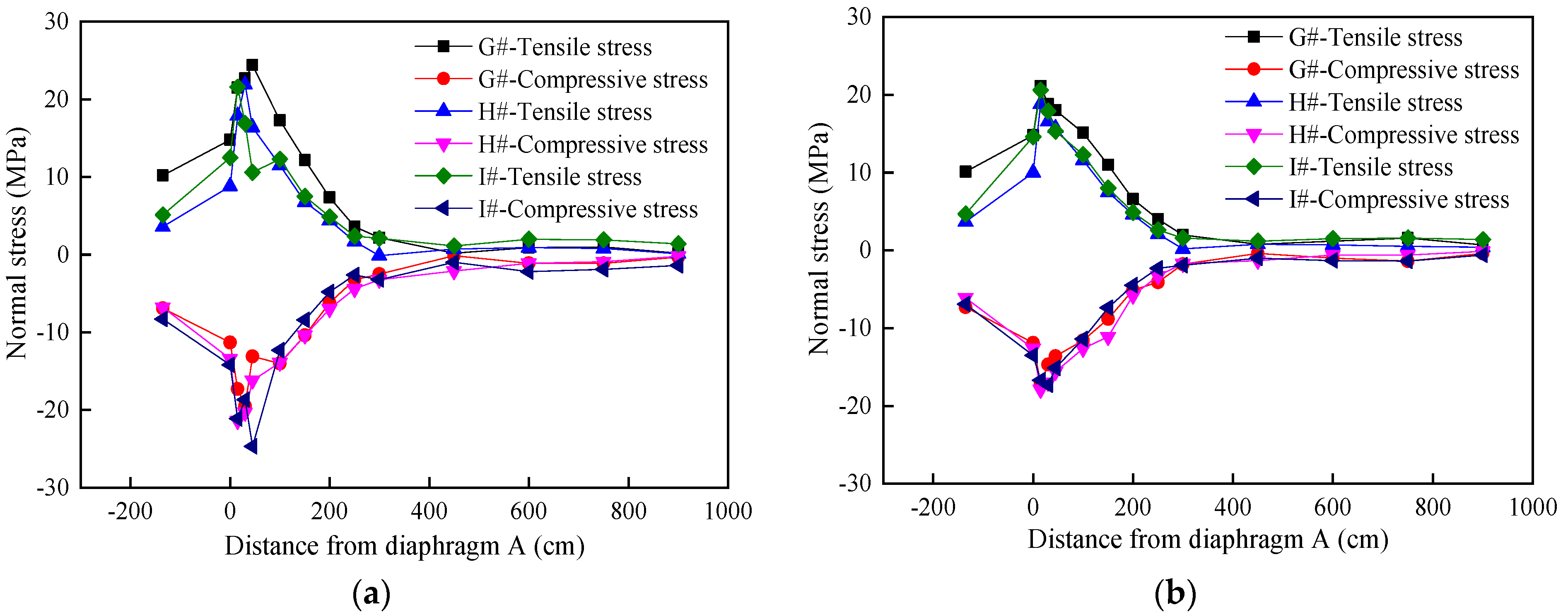
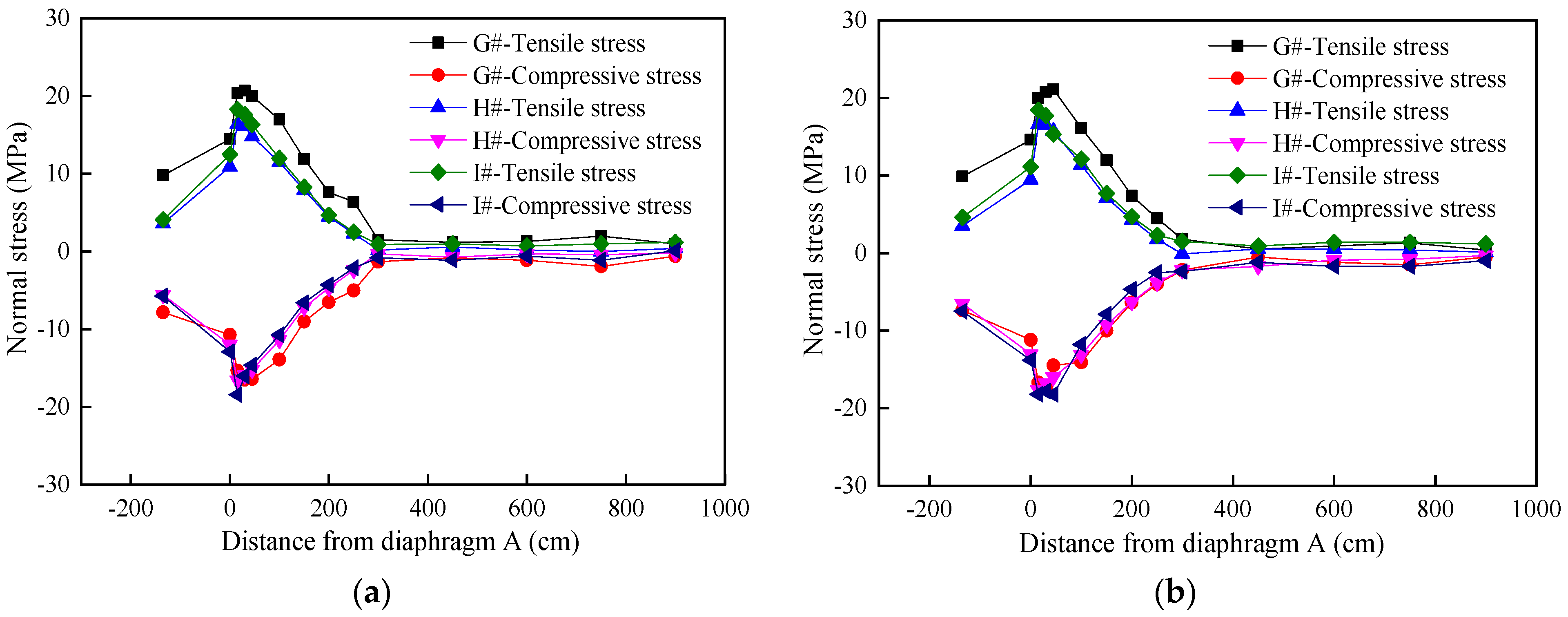

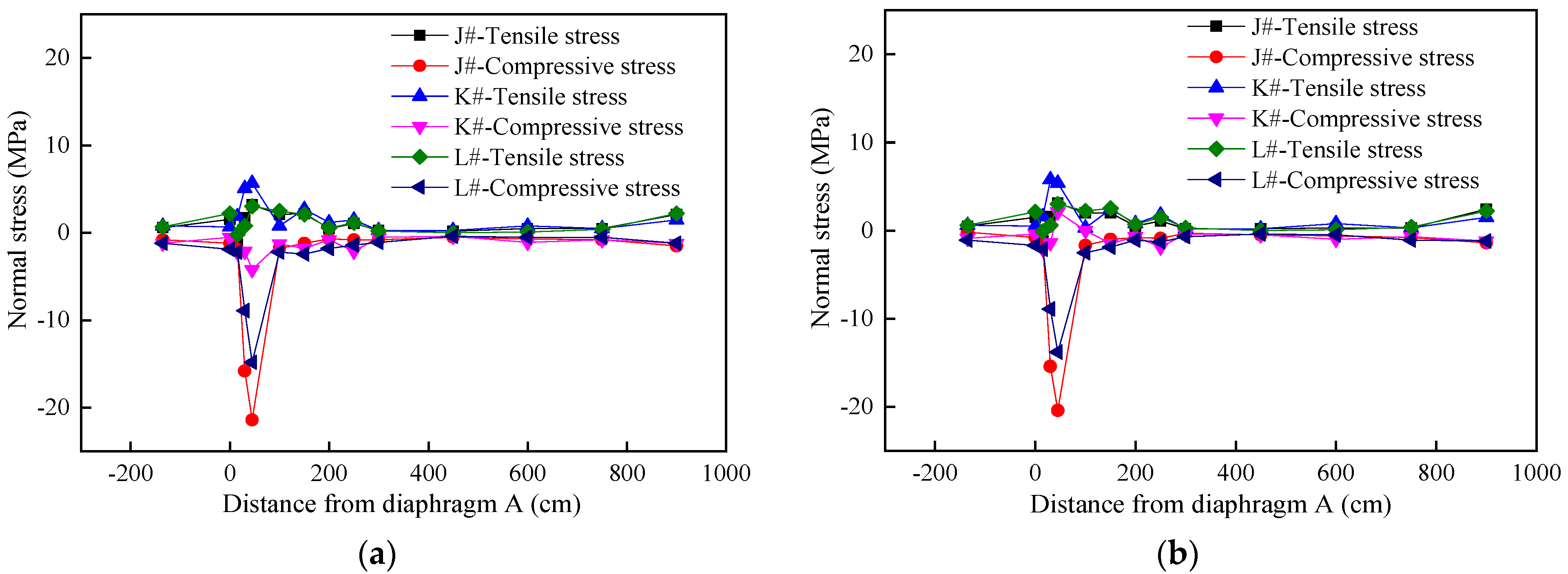
| Name | Thickness (mm) | Yield Strength (MPa) | Tensile Strength (MPa) | Modulus of Elasticity (GPa) | Maximum Elongation (%) |
|---|---|---|---|---|---|
| Q345qD | 10 | 345 | 510 | 206 | 21.5 |
| Reinforcement Method | FEA Mises Equivalent Stress Peak (MPa) | Longitudinal Loading Test Stress Peak (MPa) | Transverse Loading Test Stress Peak (MPa) |
|---|---|---|---|
| Unreinforced | 154.2 | 138.2 | 135.1 |
| Arc cut optimization | 63.5 | 59.3 | 58.5 |
| Arc cut optimization + Steel plate reinforcement | 43.2 | 38.8 | 38.3 |
Publisher’s Note: MDPI stays neutral with regard to jurisdictional claims in published maps and institutional affiliations. |
© 2022 by the authors. Licensee MDPI, Basel, Switzerland. This article is an open access article distributed under the terms and conditions of the Creative Commons Attribution (CC BY) license (https://creativecommons.org/licenses/by/4.0/).
Share and Cite
Liu, Y.; Chen, Z.; Zeng, J.; Li, C.; Peng, H.; Gao, Y. Study of Secondary Effects of Fatigue Cracks in Cross Partitions of Steel Plate Reinforced Steel Box Girders. Appl. Sci. 2022, 12, 7198. https://doi.org/10.3390/app12147198
Liu Y, Chen Z, Zeng J, Li C, Peng H, Gao Y. Study of Secondary Effects of Fatigue Cracks in Cross Partitions of Steel Plate Reinforced Steel Box Girders. Applied Sciences. 2022; 12(14):7198. https://doi.org/10.3390/app12147198
Chicago/Turabian StyleLiu, Yan, Zhuoyi Chen, Jianbo Zeng, Chuanxi Li, Hui Peng, and Youwei Gao. 2022. "Study of Secondary Effects of Fatigue Cracks in Cross Partitions of Steel Plate Reinforced Steel Box Girders" Applied Sciences 12, no. 14: 7198. https://doi.org/10.3390/app12147198
APA StyleLiu, Y., Chen, Z., Zeng, J., Li, C., Peng, H., & Gao, Y. (2022). Study of Secondary Effects of Fatigue Cracks in Cross Partitions of Steel Plate Reinforced Steel Box Girders. Applied Sciences, 12(14), 7198. https://doi.org/10.3390/app12147198






